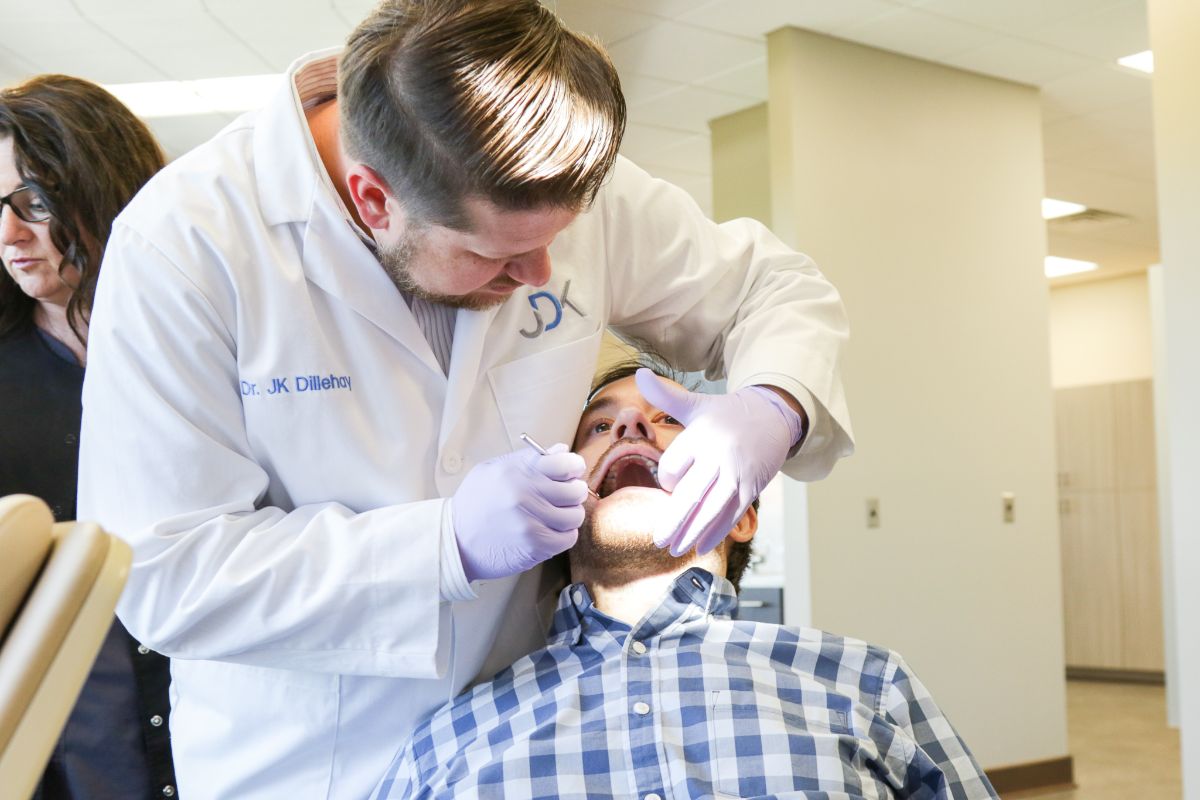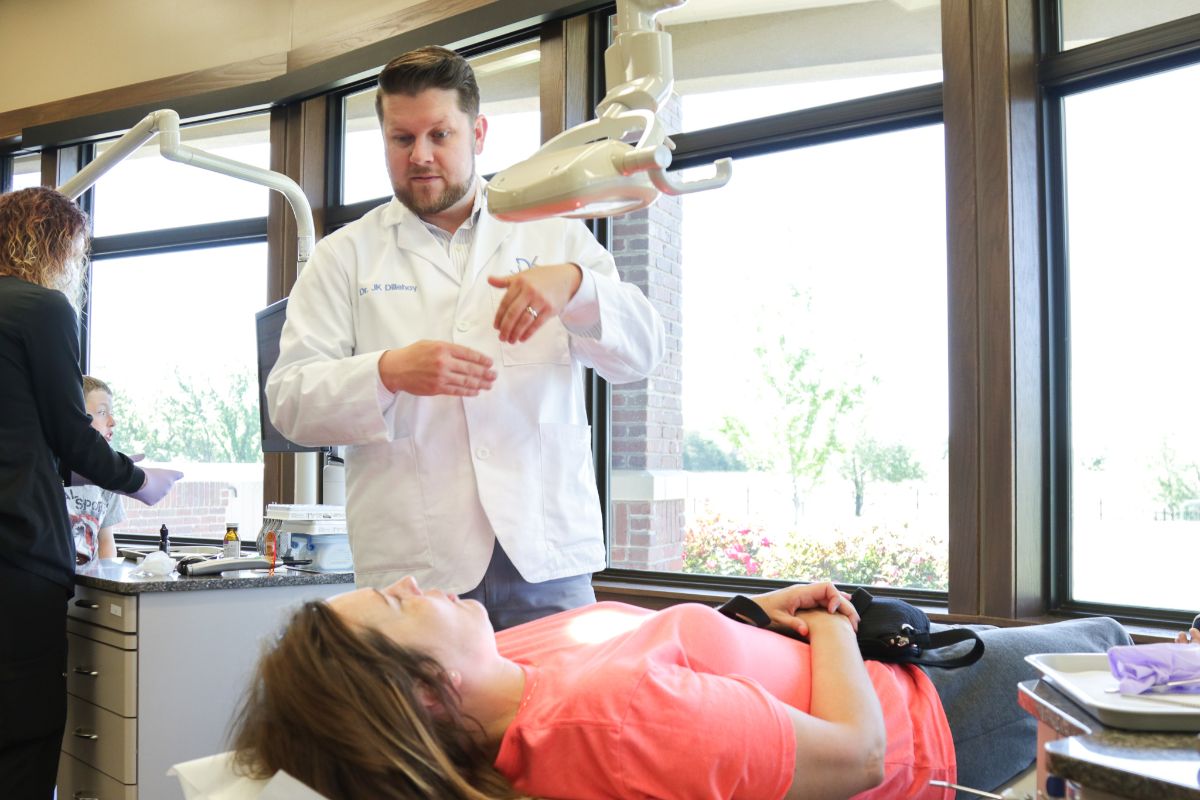Braces for adults are becoming increasingly popular. In fact, as many as 1 in every 3 current orthodontic patients is over the age of eighteen! Orthodontic treatment can benefit patients of all ages, but if you’re an adult contemplating braces, you may be wondering if they are compatible with previous dental treatments you already have in place, such as crowns, dental implants, or fillings. Here at Dillehay Orthodontics, we provide expert orthodontic advice you can trust. We want to help you feel informed and empowered as we work together to find the best solution for your smile. To learn more about the basics of getting braces with crowns, implants, or fillings, keep reading below!
Can braces work with crowns?
If you already have crowns in place from previous dental treatment, braces are still possible. If our doctors determine that traditional metal or ceramic braces are the best option for your smile, the individual brackets will be adhered to the crowns as they would the natural teeth, but we will use a different kind of adhesive. If clear aligner therapy is an option, we also offer Invisalign, or often, our many times superior, in-house aligners called Simply Clear. This treatment method consists of a series of clear, removable plastic trays that are custom designed to fit snugly over your own teeth, eliminating the need for any adhesive.
(To find out if you’re a good candidate for Invisalign or Simply Clear, contact us to schedule a FREE consultation.)
Crowns can also be used at the end of orthodontic treatment if you’re looking for a total smile makeover! Once your teeth have been straightened with braces or aligners, crowns can be applied to mask the color or shape of the teeth themselves. Combining crowns with orthodontic treatment can give you a fully functional, beautifully aligned, bright and even smile you’ll want to share with the world.
Can braces work with fillings?
It’s not at all uncommon for us to see patients with fillings who are now seeking orthodontic treatment. As a matter of fact, crooked or malaligned teeth can often contribute to a person being prone to cavities in the first place. That’s because food debris and plaque can accumulate in the gaps between the teeth, and crowded or crooked teeth make it much more difficult to clean these areas thoroughly, increasing the risk of developing tooth decay and cavities.
If you have fillings and have decided to pursue orthodontic treatment with our practice, we will first assess your whole mouth to determine how to proceed with braces considering your existing fillings. Although the actual material of your fillings shouldn’t affect treatment, bigger fillings may require spacers. These are simply tiny rubber bands that are placed between the teeth in order to provide space for a band. After the spacers have done their work, treatment should be able to proceed as normal.
Keep in mind that any cavities you currently have will need to be filled or restored before we can begin the active phase of your orthodontic treatment. Although we stress the importance of good oral hygiene during the treatment process, sometimes cavities do develop while you’re wearing braces. You can get a filling or restoration during orthodontic treatment, but because braces can be difficult to work around, occasionally a bracket will need to be removed to complete the filling. This can set your treatment plan back, so we encourage you to avoid cavities while undergoing orthodontic treatment if at all possible.
We’re happy to help you with advice on how you can most effectively clean your teeth with braces to ensure that you have the lowest risk or cavities or gum disease. Our talented team is here to answer any questions or concerns you may have about dental hygiene and oral health.
Can braces work with dental implants?
Patients who are missing teeth can sometimes benefit from orthodontics. For example, it may be possible to use braces to close the gap created by the missing tooth. For patients already dealing with overcrowding, this can be an effective option. If there’s a missing tooth that needs to be replaced, braces may be applied with a deliberate space reserved for a restoration in the future. Braces can also widen a narrow space to create enough room for a dental implant, or hold a space open so the surrounding teeth don’t move into it.
If you need orthodontics and dental implants are both needed, we will generally recommend that you have braces completed first. This is because once an implant is placed, it cannot move like a regular tooth. The implant is fixed into the jaw and does not contain ligaments that allow for tooth realignment. For many patients, orthodontic treatment may be needed to create enough space for the new implant, and to move the roots of the neighboring teeth into the correct positions.
Occasionally, it may make more sense for the dental implant to be placed before orthodontic treatment begins. If the teeth that surround the implant aren’t targeted for orthodontic treatment, there’s generally no problem with placing the implant prior to braces. The same holds true for dental implants that will be serving as an anchor point so that the appropriate forces can be applied to reposition the other teeth.
For patients who have older dental implants, there may be some natural crowding of the other teeth towards the front of the mouth as they age. If you’ve experienced this, and have noticed your implant looking out of place, we can help by using braces to move the teeth around the implant to give it a more natural look. If your dental implant is in a subpar position before beginning orthodontic treatment, it may look out of place once the rest of your teeth are aligned. In that case, you can either accept the slight imperfection in your smile, or choose to remove the implant, complete treatment, then replace the implant once your braces are removed.
Create a straighter, healthier smile with Dillehay Orthodontics
At Dillehay Orthodontics, we love to see adult patients who are excited about making an investment in their oral health using braces treatment! Both of our doctors are expert orthodontists with many years of training in both dentistry and orthodontics. That makes them experts in accommodating any previous, current, or future dental work with our innovative treatments. If you’re in Wichita or the surrounding area and would like to learn more about braces with crowns, fillings, or dental implants, our team would love to hear from you! Get in touch today to schedule a FREE consultation.


